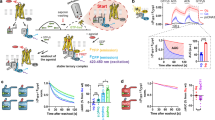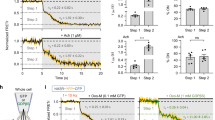Abstract
G protein–coupled receptors (GPCRs) transmit signals by forming active-state complexes with heterotrimeric G proteins. It has been suggested that some GPCRs also assemble with G proteins before ligand-induced activation and that inactive-state preassembly facilitates rapid and specific G protein activation. However, no mechanism of preassembly has been described, and no functional consequences of preassembly have been demonstrated. Here we show that M3 muscarinic acetylcholine receptors (M3R) form inactive-state complexes with Gq heterotrimers in intact cells. The M3R C terminus is sufficient, and a six-amino-acid polybasic sequence distal to helix 8 (565KKKRRK570) is necessary for preassembly with Gq. Replacing this sequence with six alanine residues prevents preassembly, slows the rate of Gq activation and decreases steady-state agonist sensitivity. That other Gq-coupled receptors possess similar polybasic regions and also preassemble with Gq suggests that these GPCRs may use a common preassembly mechanism to facilitate activation of Gq heterotrimers.
This is a preview of subscription content, access via your institution
Access options
Subscribe to this journal
Receive 12 print issues and online access
$259.00 per year
only $21.58 per issue
Buy this article
- Purchase on Springer Link
- Instant access to full article PDF
Prices may be subject to local taxes which are calculated during checkout






Similar content being viewed by others
References
Gilman, A.G. G proteins: transducers of receptor-generated signals. Annu. Rev. Biochem. 56, 615–649 (1987).
De Lean, A., Stadel, J.M. & Lefkowitz, R.J. A ternary complex model explains the agonist-specific binding properties of the adenylate cyclase-coupled beta-adrenergic receptor. J. Biol. Chem. 255, 7108–7117 (1980).
Oldham, W.M. & Hamm, H.E. Structural basis of function in heterotrimeric G proteins. Q. Rev. Biophys. 39, 117–166 (2006).
Wess, J. et al. Structural basis of receptor/G protein coupling selectivity studied with muscarinic receptors as model systems. Life Sci. 60, 1007–1014 (1997).
Rasmussen, S.G.F . et al. Crystal structure of the β2 adrenergic receptor-Gs protein complex. Nature advance online publication, <http://dx.doi.org/10.1038/nature10361> (19 July 2011).
Neubig, R.R. Membrane organization in G-protein mechanisms. FASEB J. 8, 939–946 (1994).
Hein, P. & Bunemann, M. Coupling mode of receptors and G proteins. Naunyn Schmiedebergs Arch. Pharmacol. 379, 435–443 (2009).
Rebois, R.V. & Hebert, T.E. Protein complexes involved in heptahelical receptor-mediated signal transduction. Receptors Channels 9, 169–194 (2003).
Galés, C. et al. Real-time monitoring of receptor and G-protein interactions in living cells. Nat. Methods 2, 177–184 (2005).
Galés, C. et al. Probing the activation-promoted structural rearrangements in preassembled receptor-G protein complexes. Nat. Struct. Mol. Biol. 13, 778–786 (2006).
Nobles, M., Benians, A. & Tinker, A. Heterotrimeric G proteins precouple with G protein-coupled receptors in living cells. Proc. Natl. Acad. Sci. USA 102, 18706–18711 (2005).
Tolkovsky, A.M. & Levitzki, A. Mode of coupling between the beta-adrenergic receptor and adenylate cyclase in turkey erythrocytes. Biochemistry 17, 3795 (1978).
Kuravi, S., Lan, T.H., Barik, A. & Lambert, N.A. Third-party bioluminescence resonance energy transfer indicates constitutive association of membrane proteins: application to class A G-protein-coupled receptors and G-proteins. Biophys. J. 98, 2391–2399 (2010).
Heo, W.D. et al. PI(3,4,5)P3 and PI(4,5)P2 lipids target proteins with polybasic clusters to the plasma membrane. Science 314, 1458–1461 (2006).
Yeung, T. et al. Membrane phosphatidylserine regulates surface charge and protein localization. Science 319, 210–213 (2008).
Torrecilla, I. & Tobin, A.B. Co-ordinated covalent modification of G-protein coupled receptors. Curr. Pharm. Des. 12, 1797–1808 (2006).
Lohse, M.J., Hoffmann, C., Nikolaev, V.O., Vilardaga, J.P. & Bunemann, M. Kinetic analysis of G protein-coupled receptor signaling using fluorescence resonance energy transfer in living cells. Adv. Protein Chem. 74, 167–188 (2007).
Hofmann, K.P. et al. A G protein-coupled receptor at work: the rhodopsin model. Trends Biochem. Sci. 34, 540–552 (2009).
Altenbach, C., Kusnetzow, A.K., Ernst, O.P., Hofmann, K.P. & Hubbell, W.L. High-resolution distance mapping in rhodopsin reveals the pattern of helix movement due to activation. Proc. Natl. Acad. Sci. USA 105, 7439–7444 (2008).
Scheerer, P. et al. Crystal structure of opsin in its G-protein-interacting conformation. Nature 455, 497–502 (2008).
Ye, S. et al. Tracking G-protein-coupled receptor activation using genetically encoded infrared probes. Nature 464, 1386–1389 (2010).
Yao, X.J. et al. The effect of ligand efficacy on the formation and stability of a GPCR-G protein complex. Proc. Natl. Acad. Sci. USA 106, 9501–9506 (2009).
Hein, P., Frank, M., Hoffmann, C., Lohse, M.J. & Bunemann, M. Dynamics of receptor/G protein coupling in living cells. EMBO J. 24, 4106–4114 (2005).
Qin, K., Sethi, P.R. & Lambert, N.A. Abundance and stability of complexes containing inactive G protein-coupled receptors and G proteins. FASEB J. 22, 2920–2927 (2008).
Hu, J. et al. Structural basis of G protein-coupled receptor-G protein interactions. Nat. Chem. Biol. 6, 541–548 (2010).
Ernst, O.P. et al. Mutation of the fourth cytoplasmic loop of rhodopsin affects binding of transducin and peptides derived from the carboxyl-terminal sequences of transducin alpha and gamma subunits. J. Biol. Chem. 275, 1937–1943 (2000).
Marin, E.P. et al. The amino terminus of the fourth cytoplasmic loop of rhodopsin modulates rhodopsin-transducin interaction. J. Biol. Chem. 275, 1930–1936 (2000).
Hemsath, L., Dvorsky, R., Fiegen, D., Carlier, M.F. & Ahmadian, M.R. An electrostatic steering mechanism of Cdc42 recognition by Wiskott-Aldrich syndrome proteins. Mol. Cell 20, 313–324 (2005).
Pedone, K.H. & Hepler, J.R. The importance of N-terminal polycysteine and polybasic sequences for G14alpha and G16alpha palmitoylation, plasma membrane localization, and signaling function. J. Biol. Chem. 282, 25199–25212 (2007).
McLaughlin, S. & Murray, D. Plasma membrane phosphoinositide organization by protein electrostatics. Nature 438, 605–611 (2005).
Crouthamel, M., Thiyagarajan, M.M., Evanko, D.S. & Wedegaertner, P.B. N-terminal polybasic motifs are required for plasma membrane localization of Galpha(s) and Galpha(q). Cell. Signal. 20, 1900–1910 (2008).
Ostrom, R.S., Post, S.R. & Insel, P.A. Stoichiometry and compartmentation in G protein-coupled receptor signaling: implications for therapeutic interventions involving G(s). J. Pharmacol. Exp. Ther. 294, 407–412 (2000).
Hille, B. G protein-coupled mechanisms and nervous signaling. Neuron 9, 187–195 (1992).
Jensen, J.B., Lyssand, J.S., Hague, C. & Hille, B. Fluorescence changes reveal kinetic steps of muscarinic receptor-mediated modulation of phosphoinositides and Kv7.2/7.3 K+ channels. J. Gen. Physiol. 133, 347–359 (2009).
Falkenburger, B.H., Jensen, J.B. & Hille, B. Kinetics of M1 muscarinic receptor and G protein signaling to phospholipase C in living cells. J. Gen. Physiol. 135, 81–97 (2010).
Hughes, T.E., Zhang, H., Logothetis, D.E. & Berlot, C.H. Visualization of a functional Galpha q-green fluorescent protein fusion in living cells. Association with the plasma membrane is disrupted by mutational activation and by elimination of palmitoylation sites, but not be activation mediated by receptors or AlF4. J. Biol. Chem. 276, 4227–4235 (2001).
Hynes, T.R. et al. Visualization of G protein betagamma dimers using bimolecular fluorescence complementation demonstrates roles for both beta and gamma in subcellular targeting. J. Biol. Chem. 279, 30279–30286 (2004).
Church, J.E. & Fulton, D. Differences in eNOS activity because of subcellular localization are dictated by phosphorylation state rather than the local calcium environment. J. Biol. Chem. 281, 1477–1488 (2006).
Acknowledgements
We thank G. Digby and S. Kuravi for invaluable assistance. This work was supported by US National Institutes of Health grants GM076167 (G.W.), GM096762 and GM078319 (N.A.L.).
Author information
Authors and Affiliations
Contributions
K.Q. designed and performed experiments and analyzed data; C.D. performed experiments; G.W. designed experiments and analyzed data; N.A.L. designed experiments, analyzed data and wrote the paper.
Corresponding author
Ethics declarations
Competing interests
The authors declare no competing financial interests.
Supplementary information
Supplementary Text and Figures
Supplementary Results (PDF 2178 kb)
Rights and permissions
About this article
Cite this article
Qin, K., Dong, C., Wu, G. et al. Inactive-state preassembly of Gq-coupled receptors and Gq heterotrimers. Nat Chem Biol 7, 740–747 (2011). https://doi.org/10.1038/nchembio.642
Received:
Accepted:
Published:
Issue Date:
DOI: https://doi.org/10.1038/nchembio.642
This article is cited by
-
Molecular mechanism of muscarinic acetylcholine receptor M3 interaction with Gq
Communications Biology (2024)
-
Two-step structural changes in M3 muscarinic receptor activation rely on the coupled Gq protein cycle
Nature Communications (2023)
-
Structures in G proteins important for subtype selective receptor binding and subsequent activation
Communications Biology (2021)
-
Genetic associations with clozapine-induced myocarditis in patients with schizophrenia
Translational Psychiatry (2020)
-
The in vivo specificity of synaptic Gβ and Gγ subunits to the α2a adrenergic receptor at CNS synapses
Scientific Reports (2019)



